At first glance, surfaces are boundaries. But as far back as the nature philosophers of Classical Antiquity, there was an awareness of the enigmatic character of this perception. Material, they speculated, was by no means a continuum, but consisted instead of small, ultimate elements, the átomos, themselves indivisible.
This exhibition presents works by artist Heike Klussmann, architect Thorsten Klooster, designer and artist Susanna Hertrich, and designer Clemens Winkler. In projects and experiments, they demonstrate the reciprocal action between the theoretical and material manifestations of membranes, surfaces, and boundaries, and their transitional stages between everyday objects, technology, and aesthetic production. Encountering one another here are heterogeneous scientific and artistic practices and concepts, in the process generating new modi of understanding and sensuous experience via their differences.
The concepts of the membrane, the surface, and the boundary are of equal importance in technological research, in the humanities, and in the arts, and each yields access to important if highly disparate contents. By virtue of this multiplicity, these concepts are especially well suited to bringing together an important spectrum of contemporary and historic developments in various disciplines in innovative ways. Whether visible and utilizable in the everyday context or removed from the gaze in the realm of nanotechnological materials research or on the level of biotechnological and chemical processes, boundaries condition the reality of our lived world. They define and catalyze life processes, for example those of cellular membranes, or in the form of skin, immune systems, even the ecosphere. Phenomena which occur along material boundaries play a role in the applied natural sciences, for instance in chemical process engineering (catalysis, filtration, electrophoresis), thereby representing a link to artistic production. This is manifested in the material forms of the appearances of surfaces, in medial representations in photography, film, and digital image media, but also in experiences of indifference such as Duchamp’s concept of the “Inframince,” which characterizes the almost imperceptible separation (or “simultaneous delay”), between two adjoining processes or states.
The exhibition was conceived by the Max Planck Institute for the History of Science and Kassel University jointly with the artists and serves as the upbeat to a series of events of the Aedes Network Campus Berlin. The intention is to generate a differentiated exchange between science and art. For the first time, surfaces become a space of interdisciplinary negotiation. The exhibition contributions correspond to the scientific positions of a workshop bearing the same name which was organized by the Max Planck Institute and which opens simultaneously in Dahlem.
Sponsors
Schering Stiftung, Universität Kassel / Architektur, Stadtplanung, Landschaftsplanung, Hering Hochbauen




